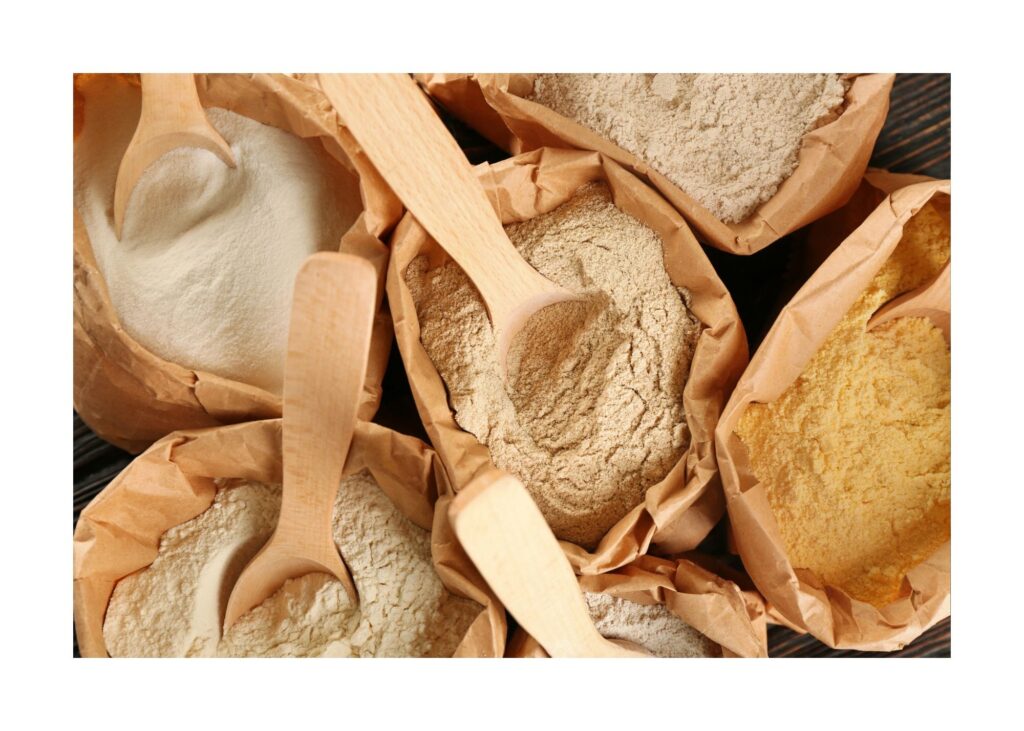Baking season is upon us, time for us to stop talking about flowers and start talking about flours, the most basic ingredient of home baking.

Types of Flour
Flour reflects the character of the wheat itself – hard, soft or a gradation of these extremes. The properties of wheat flour are affected mainly by type and variety of wheat, the specific milling operations, and the physical and chemical treatments applied after milling. Improvements in the quality of wheat and in the milling process have made possible the production of flours having specific properties for specific uses.
Hard Wheat Flour
A variety of winter or spring wheat, grown in such areas as South Dakota, Montana, and Southwest Kansas, it tends to produce a high protein flour, excellent for bread.
Soft Wheat Flour
Milled from wheat which is lower in protein, it is typical of wheat raised in Illinois and Indiana, and makes better biscuits, cakes and pastries. Since protein is an index to the amount of gluten a flour contains, lower protein flours bake into more tender products with less definition or chewiness in cellular structure.
All Purpose Flour
Because millers have found that nature does not produce any single type of wheat which would yield the flour appropriate for all home uses, All Purpose Flour is a blend of hard and soft wheat. It is the flour which will produce the best results over a wide variety of baked goods; breads, cakes, cookies, pie crusts, etc.
Self Rising Flour
A flour blend to which leavening agents and salt have been added. It is lower in protein than regular All Purpose Flour and excellent for biscuits, cakes, and pastries.
Whole Wheat Flour
Made from the entire wheat kernel, bran, endosperm and germ which has been thoroughly cleaned and ground. It contains all the natural nutrients found in wheat. Whole wheat is often called “graham” flour, but is different except in the coarseness obtained through grinding. Whole wheat flour has less baking strength than white flour. As a general rule, better results are obtained when equal parts of all purpose and whole wheat flours are combined in recipes. Because the wheat germ contains fat, whole wheat flour is more susceptible to spoilage and should be refrigerated or frozen if stored for long periods.
Medium Rye Flour
Milled from the entire rye kernel. Among the many types of rye flours, medium rye flour (which refers to the color) is the one most commonly used for bread making. Baked products made with medium rye flour have a smaller volume, more compact texture and a mild rye flavor. As with whole wheat flour, medium rye flour should be refrigerated or frozen if stored for long periods.
White Versus Whole Wheat Flour
White flour is milled from the endosperm of the wheat kernel, whereas whole wheat also includes the “bran” and “germ”. Because all purpose white flour contains essentially no bran or germ, the nutrients carried by these products of the wheat are not present in the flour.
The federal government established enrichment standards in the early 1940’s in an attempt to retain at least the “whole wheat” level of those nutrients which were of significance in a flour product in the diet. These nutrients include Iron, Thiamine, Riboflavin, and Niacin. Laws now require enrichment of white flour and bread in 30 states and there is currently a movement to increase enrichment. The level of several nutrients; sodium, calcium, phosphorous and potassium, in enriched white flour is not equal of whole grain flour.
Bleached Versus Unbleached Flours
The Food and Drug Administration defines and enforces published standards of identity for both unbleached and bleached white flour. “Unbleached” flour is wheat that is cleaned, the bran and germ removed and the endosperm milled to obtain a basic flour. Government regulations call for the term “bleached” to be used on labeling when either whitening and/or maturing agents are used.
There is no significant nutritional difference between bleached and unbleached white flour as long as they are milled from the same wheat source and to the same degree. The higher level in unbleached flour is not considered to be significant because the protein increase on a per serving basis is so minor. While some health food advocates claim nutritional superiority for unbleached flour, it is difficult to document these claims with clear cut scientific tests.
Information provided by the Pillsbury Company.